In which Sid and Doris cross two Great Divides.
This is going to be a Doris drives, Sid drives day with no obvious high point, except that we need to get over Wolf Creek Pass at 10,857′ in a car which is putting out more like deux chevaux than 36,000 lb ft.
 The day starts at the railway depot talking with a large bearded dude from Arkansas in his bib and braces with his quite normal wife. Arkansas has a hillbilly reputation of which he is clearly proud. And why not?
The day starts at the railway depot talking with a large bearded dude from Arkansas in his bib and braces with his quite normal wife. Arkansas has a hillbilly reputation of which he is clearly proud. And why not?
While Sid talks to the dude, Doris captures some photos from the original engineering in the region.
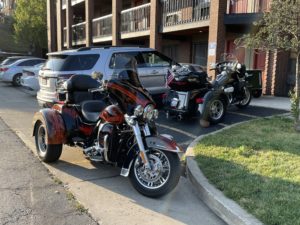 We walk back to our stylish conveyance past a modern convertible Mercedes, and “The Chain” is playing on a cafe speaker. A pair of trikes look attractive too.
We walk back to our stylish conveyance past a modern convertible Mercedes, and “The Chain” is playing on a cafe speaker. A pair of trikes look attractive too.
First drive goes to Doris which is tough because she gets to conduct 1,800 kgs of old iron, spares, luggage, souvenirs, mascots and doughty crew up the Wolf Creek Pass. We are fortunate to fall in behind a horse box which is going about 1mph faster than we could manage at full blast, and which takes all the blame from the rapidly-increasing queue of traffic for the slow progress. A Sin-Eater in mechanical form.
Sid’s skills as a navigator are also more mythical than legendary so Doris has taken the precaution of loading up the entire day’s route in RideWithGPS, the hands-free navigation system that we used on the bicycles in the EuroEpic. Doris turns out of the hotel onto the main road. ““In one hundred and seventeen and three quarters miles turn left” says the phone in a cut-glass 1959 British Broadcasting Corporation accent.
At the top we congratulate the JGG wholeheartedly on getting to 10,857′ above sea level, and remember that we did start at sea level. This is The Great Divide where rivers one side flow to the Pacific and on the other to the Atlantic or Gulf of Mexico. From now on we will be averagely going downhill though there are some hills to get over before Colorado Springs (which is not where the Colorado River rises, because that river flows to the Pacific, as we now know).
The landscape is getting greener, and with tunnels and snow sheds looking more alpine again.
A small rocky river starts by the side of the road, featuring an advert-perfect fisherman [sorry, I missed the picture – D], then wild water rafters, then RV owners in search of Solitude.
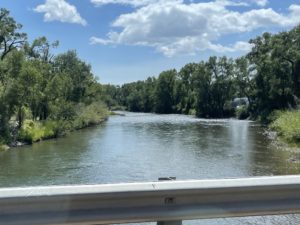 As our well-informed international reader will already know, this is the Rio Grande, eventually flowing out into the Gulf of Mexico via some sort of significant frontier.
As our well-informed international reader will already know, this is the Rio Grande, eventually flowing out into the Gulf of Mexico via some sort of significant frontier.
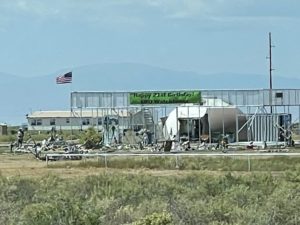 Now we are looking for some incident to break up the day and have alighted on the UFO Watchtower at a place(!) called Center. We turn off up the washboarded track and raise dust on our way to their field. Visitor Charges Apply Beyond This Point. We examine the offer from outside the gate. The UFOs appear to be some abandoned washing machines with some rusty bikes around a never-shevelled trailer home and an unconvincing space dome. This is not that incident.
Now we are looking for some incident to break up the day and have alighted on the UFO Watchtower at a place(!) called Center. We turn off up the washboarded track and raise dust on our way to their field. Visitor Charges Apply Beyond This Point. We examine the offer from outside the gate. The UFOs appear to be some abandoned washing machines with some rusty bikes around a never-shevelled trailer home and an unconvincing space dome. This is not that incident.
We are in the San Luis Valley which is sheltered and irrigate-able and possibly looked pretty attractive to the pioneers until they realised that they needed 1000 acres each merely to have a carrot patch.
The land appears fertile, at least to people who have recently emerged from the desert, but the sparseness of the houses seems to indicate otherwise.
Moffat, Salida, Howard, Cotopaxi, Canon City and Penrose pass with the only incident a Veterans’ Park with a missile and a field gun. 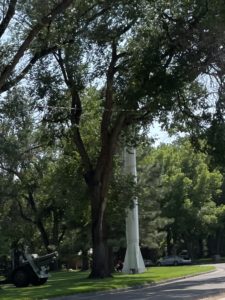 Soon after, Fremont County Airport offers a Phantom on a stick, a Bell Huey(?) and a Vietnam era med-evac Dustoff Huey(?).
Soon after, Fremont County Airport offers a Phantom on a stick, a Bell Huey(?) and a Vietnam era med-evac Dustoff Huey(?).

 Colorado was called Colorado because it is coloured red. Which is a bit odd when coming from the west, because Utah and Arizona have been much redder, but Doris does her best to photograph some red bits as we finish the final hills.
Colorado was called Colorado because it is coloured red. Which is a bit odd when coming from the west, because Utah and Arizona have been much redder, but Doris does her best to photograph some red bits as we finish the final hills.
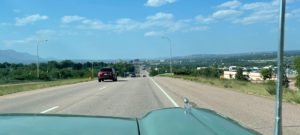
 We are into the surprisingly flat town of Colorado Springs at 4.30, JGG gets a bit hot in the traffic and is gratefully handed to the valet parking driver at the Mining Exchange, ‘the handsomest, largest and most substantial structure in the city’ in 1902, and now a Wyndham Grand Hotel.
We are into the surprisingly flat town of Colorado Springs at 4.30, JGG gets a bit hot in the traffic and is gratefully handed to the valet parking driver at the Mining Exchange, ‘the handsomest, largest and most substantial structure in the city’ in 1902, and now a Wyndham Grand Hotel.
As the Mining Exchange it was a stock exchange and bullion trading centre for the local mining firms. And money flowed down hill from the mines, via the trails and rails to Colorado Springs. The Exchange was built of granite, steel and brick on a site considered too far out of town. It became the centre and was one of the highest volume stock exchanges in the world in the 1900s. We are now sitting in the double height, ground floor trading floor where in one wall is large safe for gold and share certificates. (Sid can remember the safe at Schroders where the share certificates were kept.) The Mining Exchange had two Otis elevators and marble toilets. There’s posh.
It was then abandoned for years with renovation starting in 2009, in the middle of the recession. Rather like the Belvada at Tonopah there is a Victorian feel to some of the decor, though the music is all Motown, and they have done a very good job.
Having got in early we go walking to find a cash machine (much card rejection and Doris dejection), local history (pleasant statuary) and somewhere to eat (third degree milling with only two participants).
We stop for a beer and realise that Friday night is cruise night. And looky here: a lowered Ford Country Squire in blue and white, no wood and with the chrome roof rails. We should have gone to get the JGG from valet driver and gone cruising, but somehow the energy wasn’t there.
And that is why we are having two nights in Colorado Springs cheerful in the knowledge we are over the great divide and more than half-way along our planned route to Kansas City and then Nashville before turning north for New Jersey.
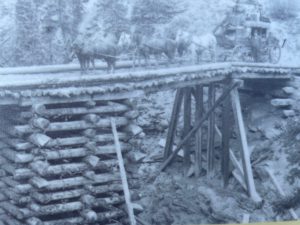

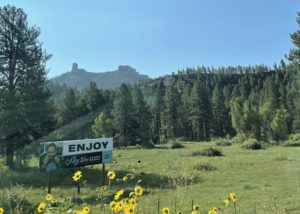
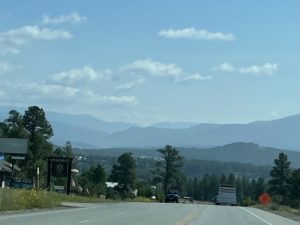
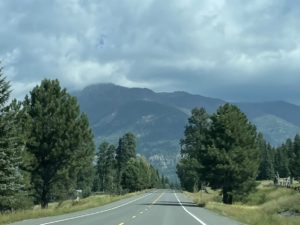

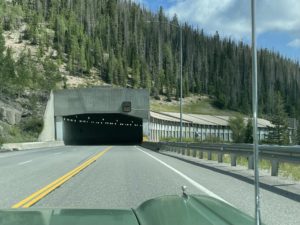
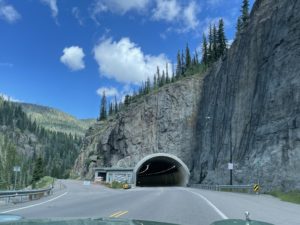
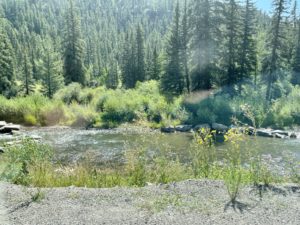


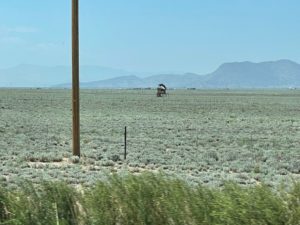

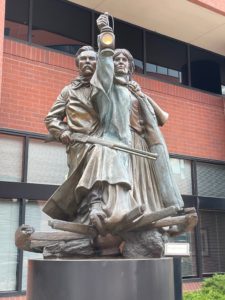
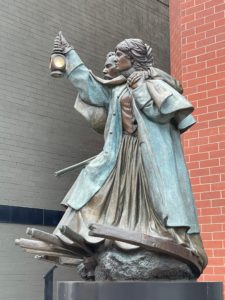
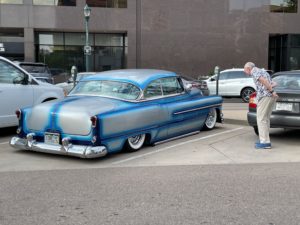

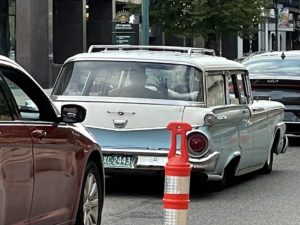
Thank you for the planes-on-sticks entry!
It is now a conditioned reflex. See plane take photo get Sid to work out what it was. Keeps him out of mischief 🙂